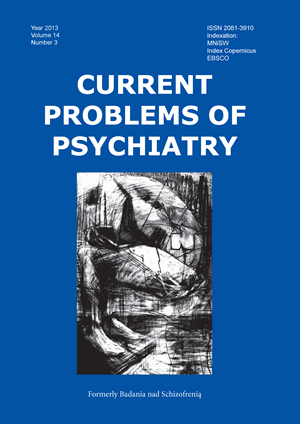The spatial conditioning in the incidence of depressive and neurotic disorders in a medium-size Polish town
Keywords:
affective disorders, neurotic disorders, urban areasAbstract
Background: Most of research studies conducted so far have shown a frequent incidence of depression and neuroses in cities compared to rural and to suburban areas.
Aims: We wanted to compare the geographic distribution of affective and neurotic disorders in Polish medium-size town.
Methods: The following research work was carried out in a medium-size town based on address data of people placed in psychiatric hospitals for affective and neurotic disorders in the years 1989-2002. In order to study the differences among particular districts of the town the test for two proportions was applied.
Results and Conclusions: The analyzed group of persons included 311 patients, 141 men and 170 women. It was indicated that patients more frequently lived in the centers of towns as well as women aged 20-29 year in postindustrial districts and women (40-49) and men (50-59) in districts with city housing projects. It should be mentioned that more patients lived in the center of towns, but also in postindustrial districts and in districts with city housing projects.
References
1. Eaton W, Kesler L. Rates of symptoms of depression in a national sample. Am J Epidemiol 1981; 144:528-538.
2. Kessler RC, Barker PR, Colpe LJ, Epstein JF, Gfroerer JC, Hiripi E,et al. Screening for serious mental illness in the general population. Arch Gen Psychiatry 2003; 60:184-189.
3. Widerlöv B, Borgǻ P, Cullberg J, Stefansson CG, Lindqvist G. Epidemiology of long-term functional psychosis in three different areas in Stockholm County. Acta Psychiatr Scand 1989; 80:40-46.
4. Blazer DG, George LK, Landerman R, Pennybacker M, Melville ML, Woodbury M, et al. Psychiatric Disorders: A Rural/Urban Cmparision. Arch Gen Psychiat 1985; 42:651-656.
5. Canino G, Bird H, Shrout P, Rubio-Stipec M, Bravo M, Martinez R, et al.The Prevalence of Specific Psychiatric Disorders in Puerto Rico. Arch Gen Psychiatry 1987;44:727-735.
6. Vega WA, Kolody B, Aguilar-Gaxiola S, Alderete E, Catalano R, Caraveo-Anduaga J. Lifetime Prevalence of DSM-III-R Psychiatric Disorders among Urban and Rural Mexican Americans in California. Arch Gen Psychiat 1998; 55:771-778.
7. Paykel E, Abbott R, Jenkins R, Brugha T, Meltzer H. Urban-rural mental health differences in Great Britain: findings from the National Morbidity Survey. Int Rev Psychiatry 2003; 15:97-107.
8. Romans S, Cohen M, Forte T.Rates of depression and anxiety in urban and rural Canada.Soc Psychiatry Psychiatr Epidemiol 2011; 46:567-575.
9. Probst JC, Laditka SB, Moore CG, Harun N, Paige Powell M, Baxley EG. Rural-Urban Differences in Depression l Prevalence: Implications for Famiy Medicine. Fam Med 2006; 38:6536-60.
10. Neff J. Urbanicity and depression reconsidered: the evirdence egarding depressive symptomatology. J Nerv Ment Dis 1983; 171:546-552.
11. Kovess V, Murphy HBM, Tousignant M. Urban-rural foe comparisons o depressive disrders in Frnch Canada. J Nerv Ment Dis 1987; 175:457-465.
12. Hwu HG, Yeh EK, Chang LY. Prevalence of psychiatric disorders in Taiwan defined by the Chinese Diagnostic Interview Schedule. Acta Psychiatr Scand 1989;79:136-147.
13. Lee CK, Kwak YS, Yamamoto J, Rhee H, Kim YS, Han JH,et al Psychiatric epidemiology in Korea. Part II. Urban and rural differences. J Nerv Ment Dis 1990; 178:247-252.
14. Parikh SV, Wasylenki D, Goering P, Wong J. Mood disorders: rural/urban differences in prevalence, health care utilization, and disability in Ontario. J Affect Disord 1996; 38:57-65.
15. Dottl SL, Greenley JR. Rural-Urban Differences in Psychiatric Status and Functioning Among Clients with Severe Mental Illness. Community Ment Health J 1997; 4:311-321.
16. Wang JL. Rural-urban differences in the prevalence of major depression and associated impairment. Soc Psychiatry Psychiatr Epidemiol 2004; 39:19-25.
17. Faris REL, Durham HW. Mental disorders in urban areas. An ecological study of schizophrenia and other psychoses. Chicago/London: The University of Chicago Press, 1967.
18. World Health Organization. The ICD-10 Classification of Mental and Behavioural Disorders. Diagnostic Criteria for Research. Geneva: World Health Organization; 1993.
19. Park ER, Burgess EW. The City. Suggestions for Investigation of Human Behavior in the Urban Environment. Chicago/London: The University of Chicago Press, 1984.
20. Almeida-Filho N, Lessa I, Magalhäes L, Araújo MJ, Acquino E, James SA, Kawachi I. Social inequality and depressive disorders in Bahia, Brazil: Interactions of gender, ethnicity, and social class. Soc Sci Med 2004; 59:1339-1353.
21. Parkar SR, Fernandes J, Weiss MG. Contextualizing mental health: Gendered experiences in a Mumbai slum. Anthropology&Medicine 2003; 10:291-308.
22. Kovess-Mastefy V, Alonso J, de Graaf R, Demyttenaere K.A European Approach to Rural-Urban Differences in Menetal Health: ThESEMeD 2000 Comparative Study. Can J Psychiatry 2005;14:926-935.
23. Sundquist K, Frank G, Sundquist J. Urbanisation and incidence of psychosis and depression: follow-up study of 4,4 million women and men in Sweden. Br J Psychiatry2004; 184:293-298.
24. Giggs JA, Cooper JE. Ecological Structure and the Distribuition of Schzophreniaand Affective Psychoses inNottingham. Br J Psychiatry 1987; 151:627-633.
25. Häfner H, Reimann H, Immich H, Martini H. Inzidenz seelischer Erkrankungen in Mannheim. Soc Psychiatry 1969; 4:125-135.
26. Maylath E, Weyerer S, Häfner H. Spatial concentration of the incidence of treated psychiatric disorders in Manheim. Acta Psychiatr Scand 1989; 80:650-656.
27. Greenley JR, Dottl SL. Sociodemographic Characteristics of Severely Mentally Ill Clients in Rural and Urban Counties. Community Ment Health J 1997; 6:545-551.


